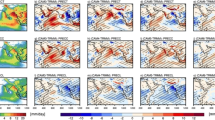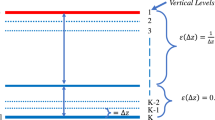Abstract
This paper examines the sensitivity of CAM3.1 simulations of East Asian summer monsoon (EASM) to the choice of dynamic cores using three long-term simulations, one with each of the following cores: the Eulerian spectral transform method (EUL), semi-Lagrangian scheme (SLD) and finite volume approach (FV). Our results indicate that the dynamic cores significantly influence the simulated fields not only through dynamics, such as wind, but also through physical processes, such as precipitation. Generally speaking, SLD is superior to EUL and FV in simulating the climatological features of EASM and its interannual variability. The SLD version of the CAM model partially reduces its known deficiency in simulating the climatological features of East Asian summer precipitation. The strength and position of simulated western Pacific subtropical high (WPSH) and its ridge line compare more favourably with observations in SLD and FV than in EUL. They contribute to the intensification of the south-easterly along the south of WPSH and the vertical motion through the troposphere around 30° N, where the subtropical rain belt exists. Additionally, SLD simulates the scope of the westerly jet core over East Asia more realistically than the other two dynamic cores do. Considerable systematic errors of the seasonal migration of monsoon rain belt and water vapour flux exist in all of the three versions of CAM3.1 model, although it captures the broad northward shift of convection, and the simulated results share similarities. The interannual variation of EASM is found to be more accurate in SLD simulation, which reasonably reproduces the leading combined patterns of precipitation and 850-hPa winds in East Asia, as well as the 2.5- and 10-year periods of Li–Zeng EASM index. These results emphasise the importance of dynamic cores for the EASM simulation as distinct from the simulation’s sensitivity to the physical parameterisations.









Similar content being viewed by others
References
Adler R, Susskind J, Huffman G, Bolvin D, Nelkin E, Chang A, Ferraro R, Gruber A, Xie P, Janowiak J (2003) The version-2 Global Precipitation Climatology Project (GPCP) monthly precipitation analysis (1979–present). J Hydrometeorol 4:1147–1167
Baer F, Wang H, Tribbia J, Fournier A (2006) Climate modeling with spectral elements. Mon Wea Rev 134:3610–3624
Chen M, Bates J (1996) A comparison of climate simulations from a semi-Lagrangian and an Eulerian GCM. J Climate 9:1126–1149
Chen H, Zhou T, Neale R, Wu X, Zhang G (2010) Performance of the new NCAR CAM3.5 model in East Asian summer monsoon simulations: sensitivity to modifications of the convection scheme. J Climate. doi:10.1175/2010JCLI3022.1
Collins W, Rasch P, Boville B, McCaa J, Williamson D, Kiehl J, Briegleb B, Bitz C, Lin S, Zhang M (2004) Description of the NCAR community atmosphere model (CAM3.0), technical note tn-464+ str. National Center for Atmospheric Research, 214 pp, Boulder, CO
Collins W, Bitz C, Blackmon M, Bonan G, Bretherton C, Carton J, Chang P, Doney S, Hack J, Henderson T (2006a) The community climate system model: CCSM3. J Climate 19:2122–2143
Collins W, Rasch P, Boville B, Hack J, McCaa J, Williamson D, Briegleb B, Bitz C, Lin S, Zhang M (2006b) The formulation and atmospheric simulation of the Community Atmosphere Model version 3 (CAM3). J Climate 19:2144–2161
Delworth T, Broccoli A, Rosati A, Stouffer R, Balaji V, Beesley J, Cooke W, Dixon K, Dunne J, Dunne K (2006) Gfdl's CM2 global coupled climate models. Part I: formulation and simulation characteristics. J Climate 19:643–674
Ding YH (2007) The variability of the Asian summer monsoon. J Meteorol Soc Jpn 85B:21–54
Dong M (2001) Introduction to National Climate Center atmospheric general circulation model documentation—basic principles and applications. China Meteorological Press, Beijing, p 152
Eitzen Z, Randall D (1999) Sensitivity of the simulated Asian summer monsoon to parameterized physical processes. J Geophys Res 104:177–191
Feng J, Li J, Li Y (2010) A monsoon-like Southwest Australian circulation and its relation with rainfall in Southwest Western Australia. J Climate 23:1334–1353
Ferranti L, Slingo J, Palmer T, Hoskins B (1997) Relations between interannual and intraseasonal monsoon variability as diagnosed from AMIP integrations. Q J Roy Meteor Soc 123:1323–1357
Giraldo F, Rosmond T (2004) A scalable spectral element Eulerian atmospheric model (SEE-AM) for NWP: dynamical core tests. Mon Wea Rev 132:133–153
Gordon H, Rotstayn L, McGregor J, Dix M, Kowalczyk E, OFarrell S, Waterman L, Hirst A, Wilson S, Collier M (2002) The CSIRO Mk3 climate system model [electronic publication]. CSIRO Atmospheric Research technical paper no 60
Held I, Suarez M (1994) A proposal for the intercomparison of the dynamical cores of atmospheric general circulation models. Bull Amer Meteor Soc 75:1825–1830
Hoskins B, Rodwell M (1995) A model of the Asian summer monsoon. Part I: the global scale. J Atmos Sci 52:1329–1329
Hussaini M, Zang T (1987) Spectral methods in fluid dynamics. Ann Rev of Fluid Mech 19:339–367
Kalnay E, Kanamitsu M, Kistler R, Collins W, Deaven D, Gandin L, Iredell M, Saha S, White G, Woollen J (1996) The NCEP/NCAR 40-year reanalysis project. Bull Am Meteor Soc 77:437–472
Kang I, Ho C, Lim Y, Lau K (1999) Principal modes of climatological seasonal and intraseasonal variations of the Asian summer monsoon. Mon Wea Rev 127:322–340
Kang I, Jin K, Wang B, Lau K, Shukla J, Krishnamurthy V, Schubert S, Wailser D, Stern W, Kitoh A (2002) Intercomparison of the climatological variations of Asian summer monsoon precipitation simulated by 10 GCMs. Clim Dyn 19:383–395
Kim K, Kitoh A, Ha K (2008) The SST-forced predictability of the sub-seasonal mode over East Asia with an atmospheric general circulation model. Int J Climatol 28:1599–1606
Li J, Chou J (1998) Dynamical analysis on splitting of subtropical high-pressure zone. Chin Sci Bull 43:1285–1289
Li J, Zeng Q (2002) A unified monsoon index. Geophys Res Lett 29:1151–1154
Liang X, Wang W (1998) Associations between China monsoon rainfall and tropospheric jets. Q J Roy Meteor Soc 124:2597–2623
Lin S (2004) A “vertically Lagrangian” finite-volume dynamical core for global models. Mon Wea Rev 132:2293–2307
Lin S, Rood R (1997) An explicit flux-form semi-Lagrangian shallow-water model on the sphere. Q J Roy Meteor Soc 123:2477–2498
Machenhauer B (1979) The spectral method. In: Numerical methods used in atmospheric models. World Meteorological Organization, Geneva, Switzerland, pp 121–275
Martin G (1999) The simulation of the Asian summer monsoon, and its sensitivity to horizontal resolution, in the UK Meteorological Office unified model. Q J Roy Meteor Soc 125:1499–1525
Martin G, Ringer M, Pope V, Jones A, Dearden C, Hinton T (2006) The physical properties of the atmosphere in the new Hadley Centre Global Environmental Model (HadGEM1). Part I: model description and global climatology. J Climate 19:1274–1301
Meehl G, Arblaster J, Lawrence D, Seth A, Schneider E, Kirtman B, Min D (2005) Monsoon regimes in the CCSM3. J Climate 19:2482–2495
Mishra S, St-Cyr A, Tufo H, Edwards J, Tribbia J, Evans K, Taylor M, Lauritzen P, Nair R, Kelly R (2010) Performance of the HOMME dynamical core in the simulation of rainfall: real-planet study with CAM3.5. http://www.cisl.ucar.edu/tdd/amip-posterpdf
Neale R, Richter J, Conley A, Park S, Lauritzen P, Gettelman A, Williamson D, Richland W, Vavrus S, Madison W (2010) Description of the NCAR Community Atmosphere Model (CAM 4.0). Technical note NCAR/TN-??? + STR National Center for Atmospheric Research, 194 pp, Boulder, CO
Roeckner E, B uml G, Bonaventura L, Brokopf R, Esch M, Giorgetta M, Hagemann S, Kirchner I, Kornblueh L, Manzini E (2003) The atmospheric general circulation model ECHAM5: part 1: model description, vol 349. Max Planck Institute for Meteorology Rep, Hamburg
Staniforth A, Cote J (1991) Semi-Lagrangian integration schemes for atmospheric models—a review. Mon Wea Rev 119:2206–2223
Waliser D, Jin K, Kang I, Stern W, Schubert S, Wu M, Lau K, Lee M, Krishnamurthy V, Kitoh A (2003) AGCM simulations of intraseasonal variability associated with the Asian summer monsoon. Clim Dyn 21:423–446
Wang B, Ding Q, Fu X, Kang I, Jin K, Shukla J, Doblas-Reyes F (2005) Fundamental challenge in simulation and prediction of summer monsoon rainfall. Geophys Res Lett 32:L15711
Wang B, Wu Z, Li J, Liu J, Chang C, Ding Y, Wu G (2008) How to measure the strength of the East Asian summer monsoon. J Climate 21:4449–4463
Webster P, Magana V, Palmer T, Shukla J, Tomas R, Yanai M, Yasunari T (1998) The monsoon: processes, predictability and prediction. J Geophys Res 103:14451–14510
Williamson D, Olson J (1994) Climate simulations with a semi-Lagrangian version of the NCAR community climate model. Mon Wea Rev 122:1594–1610
Williamson D, Olson J (1997) A comparison of semi-Lagrangian and Eulerian polar climate simulations. Mon Wea Rev 126:991–1000
Williamson D, Rasch P (2002) Water vapor transport in the NCAR CCM2. Tellus Ser A 46:34–51
Williamson D, Olson J, Boville B (1997) A comparison of semi-Lagrangian and Eulerian tropical climate simulations. Mon Wea Rev 126:1001–1012
Williamson D, Olson J, Jablonowski C (2009) Two dynamical core formulation flaws exposed by a baroclinic instability test case. Mon Wea Rev 137:790–796
Yang S, Lau K-M (2006) Interannual variability of the Asian monsoon. In: Bin Wang (ed) The Asian monsoon. Praxis, Chichester, pp 259–294
Zaizhi W, Guoxiong W, Tongwen W, Rucong Y (2004) Simulation of Asian monsoon seasonal variations with climate model R42L9/LASG. Adv Atmos Sci 21:879–889
Zhang Y, Sperber K, Boyle J, Dix M, Ferranti L, Kitoh A, Lau K, Miyakoda K, Randall D, Takacs L (1997) East Asian winter monsoon: results from eight AMIP models. Clim Dyn 13:797–820
Zhang Y, Kuang X, Guo W, Zhou T (2006) Seasonal evolution of the upper-tropospheric westerly jet core over East Asia. Geophys Res Lett 33:L11708
Zhou T, Li Z (2002) Simulation of the East Asian summer monsoon using a variable resolution atmospheric GCM. Clim Dyn 19:167–180
Zhou T, Yu R, Zhang J, Drange H, Cassou C, Deser C, Hodson D, Sanchez-Gomez E, Li J, Keenlyside N (2009) Why the Western Pacific subtropical high has extended westward since the late 1970s. J Climate 22:2199–2215
Acknowledgments
The simulations were performed at the GCESS high performance centre at BNU. This work was supported by the National Basic Research Program of China under Grant No. 2010CB950500.
Author information
Authors and Affiliations
Corresponding author
Rights and permissions
About this article
Cite this article
Wei, T., Wang, L., Dong, W. et al. A comparison of East Asian summer monsoon simulations from CAM3.1 with three dynamic cores. Theor Appl Climatol 106, 295–306 (2011). https://doi.org/10.1007/s00704-011-0409-9
Received:
Accepted:
Published:
Issue Date:
DOI: https://doi.org/10.1007/s00704-011-0409-9




